KAPPA 河童. One of the Suijin 水神 (water kami, water deities) of Shinto mythology. Suijin are found in lakes, ponds, springs, wells, and irrigation waterways. They are often depicted as a snake, a dragon, an eel, a fish, a turtle, or a kappa. One of the most curious Suijin in Japan manifests itself as the water-cleansing bacteria in sewage water (details here). According to the Institute for Japanese Culture and Classics (Kokugakuin University), women have played an important role in the history of Suijin worship in Japan. With the introduction of Buddhism in the 6th century AD, however, Japan's many Shinto water kami begin to slowly absorb Buddhist attributes. Not surprisingly, this ongoing mixture of traditions makes it difficult to identify the origins of these "syncretic" deities. This difficulty is compounded by the lack of Shinto artwork or written records prior to the 8th century. For details on Japan's SUIJIN traditions, please see the Suijin Page (aka Suiten, Mizu no Kamisama).
KAPPA LORE. Kappa smell like fish and are generally portrayed with the body of a tortoise, ape-like head, scaly limbs, long hair circling the skull, webbed feet and hands, and yellow-green skin. They are often depicted with a tortoise shell attached to their backs. Some say they can change color like the chameleon. They abhor metal objects and loud noises (cannon fire, gunfire, etc.).
The defining characteristic of the Kappa is the hollow cavity atop its head. This saucer-like depression holds a strength-giving fluid. Should you chance upon the quarrelsome Kappa, please remember to bow deeply. If the courteous Kappa bows in return, it will spill its strength-giving water, making it feeble, and forcing it to return to its water kingdom.
About the size of a child aged 6 to 10, the Kappa is nonetheless incredibly strong. It attacks horses, cattle, and humans, usually dragging its prey into the water, where, according to various legends, it feeds on their blood, or drains their life force, or pulls out their livers through their anuses, or sucks out their entrails, leaving nothing behind except a hollow gourd. Stories tell of Kappa pulling little children into the water and drowning them. In many localities, drowning is still referred to as GAPPADOKO (ガーッパドコ). As drowning victims were sometimes found with a distended anus (swollen rectal), the Kappa is also sometimes called the shirokodama (anus) vampire. In some tales, the Kappa is associated with theft and raping women.
Kappa are mostly evil, but not always. When benevolent, the Kappa is supposedly a skilled teacher in the art of bone setting and other medical skills. In the real world of medicine, the term "kappa" refers to a monoclonal plasma cell related to bone marrow. (Note: Not yet able to confirm Kappa's bone-setting skills; but sounds very plausible, as most Shinto "kami" have some redeeming qualities.) In addition, the Kappa is always portrayed as trustworthy despite its many evil ways. When captured and forced to promise never again to harm anyone, the kappa always keeps its promise. Kappa often help or mentor those who outwit them or capture them.
 THEORIES ON KAPPA ORIGINS
THEORIES ON KAPPA ORIGINS
The Kappa's origin is difficult to verify precisely. But, by the Edo Period, illustrations of Kappa appear often in anthologies of supernatural tales, in comical paintings (giga), in ukiyo-e (woodblock prints), and in paintings accompanying verse (haiga). In 1910, Kappa lore gained nationwide popularity with the publication of Tono Monogatari (遠野物語; Legends of Tono) by Yanagida Kunio (1875-1962). In Tono Monogatari, Yanagida presented numerous tales of supernatural beings in the Tono area, including stories about the evil Kappa. Today the Kappa is typically depicted as a cute cartoon-like character (see photos below), and appears quite regularly in Japanese fiction, in cartoons for children (Urusei Yatsura, Tenchi Universe), as a cute mascot for commercial products, and in toys.
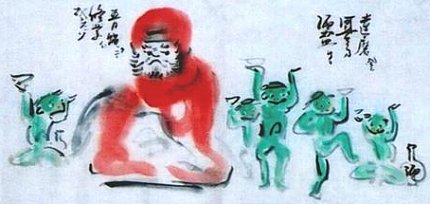
Modern Kappa Paintings from Gabi Greve Collection
Yamashina-e & Otsu-e Photos of Kappa
Paintings by artist Yoshio Yamamoto
COMBAT, SUMO, & CUCUMBERS
The chief delight of the quarrelsome Kappa is to challenge humans to single combat. Indeed, the Kappa delights in Japanese Sumo wrestling, and often challenges its victim to a sumo bout.
Kappa folk have a liking for cucumbers, a weakness that can be used to human advantage. According to one tale, an offering of cucumbers (on which are etched the name/age of family members) is enough to appease the Kappa, who thereafter will refrain from harming you and your family (need to find source for this). Even today, cucumber sushi in Japan is called "Kappa-maki".
KAWAKO KAPPA
The Kappa is sometimes called Kawako (literally "river child"). The name can be traced to Kawako-no-miya (Shrine of the Kawako), located on the bank of the Kawachi river near Matsue/Izumo. Legend relates that a nasty Kappa was captured near here and forced to sign a note swearing never again to harm any of the people or animals in the area. Unable to write, the Kappa dipped its hand in the ink and pressed it on the document. The document remained among the shrine's relics, and the Kappa never broke the promise (the Kappa is always portrayed as trustworthy and courteous despite its many evil ways).
KAPPA BRIDGE IN TOKYO
Tokyo's Kappabashi (Kappa bridge) was once farmland surrounded by canals prone to flooding. In the late Edo period a raincoat dealer Kappaya Kihachi devoted his entire personal fortune to building a drainage system. This difficult work took longer than expected and cost a fortune, and he was in despair until a kappa, whose life he had saved years before, suddenly appeared to help. With the kappa's assistance the project was completed in short order. In addition, those who had seen the Kappa were suddenly blessed with good fortune and soon the Kappa Temple was built, and the Kappa enshrined as a deity.Janet Leigh Foster for japantoday.com>.
HOW GENTA SUBDUED A KAPPA:
See below woodblock print.
The following myth has been passed down through the ages in Saga Prefecture. It was translated by Keiko Takada and Eriko Tsudo of Saga Women's Junior College, and appears on the Saga Pref. Government site at:
www.pref.saga.jp/soumu/kokusai/
sagasaga/archives/sagasaga9809.htm
Once upon a time in the village of Kawachino there lived a man named Genta. He was from a distinguished family in the village and was so wise and brave that he was greatly respected by the villagers. His house was large and stood near a river which flowed through the village. The river was at its deepest at the bend near his house, and the water looked dark and unfathomable, being over six meters deep.
One summer evening, Genta came back from his outing and told his servants as usual to hitch his horse to a shady tree near the river. After taking a short rest, Genta stepped out into the garden and looked at the tree. To his surprise, a kappa, the size of a 6-7 year old boy was dragging the horse by its hind legs into the river. The silent horse was resisting the pull with its forelegs while strangely enough, the servant as if in a trance, was helping the small kappa by pouring water into the cavity on the kappa's head. The more the servant poured, the more powerful the kappa became.
Although Genta became very angry watching this scene, he had the presence of mind to think of a plan. From the shed he fetched a strong rope made of hemp palm and snuck up to the kappa from behind. Neither the servant nor the kappa noticed Genta's actions. He quickly caught hold of the kappa and dragged him away from the river, tying him up with the rope.
All of a sudden, the servant came out of his trance and followed his master's direction to hang the kappa upside down from the pine tree in the garden. Genta glared at the wicked water imp and reprimanded him. "What an insolent fellow you are! You take so much pride in your bit of supernatural powers and even try to steal horses from humans. You are very sinful indeed. I shall kill you as a warning to all of your fellow kappa."
With the precious water drained from his cavity, the kappa lost all his magic powers. The more he struggled, the tighter the rope cut into his flesh, making the pain even harder to bear. At last the kappa began to cry in a strange, harsh voice "please forgive me for mercy's sake my lord," he implored. "I'll not fail to make up for this crime, so please let me go." In tears, the the kappa begged Genta over and over again.
A kind hearted man by nature, Genta felt pity for the ugly creature who was crying. "If you swear with all your heart, I'll forgive you," he said to the kappa "but first, you must confess your sins and make restitution."
"I confess to you that I've done many wrongs," the kappa said. "I regret my past actions very much. Your authority is astonishing, so I promise you that even if the Kawachino River should flow upstream, I won't pull the people from this village into the water. Never will I do anything wrong again. Please spare my life today. I also promise to make all my fellow kappa keep this oath forever."
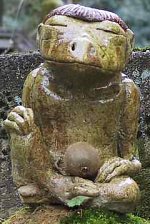
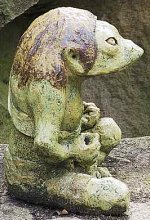
Kappa Statues at Gokoku Shrine, Gifu City
Photos by Reggie Thomson (http://www.reggie.net)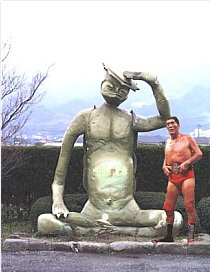
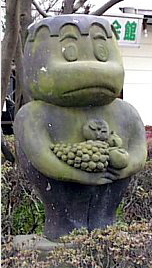
LEFT: Giant Kappa statue near Tanukimachi Station
田主丸駅舎 Tanuki Machi Station, Fukuoka Prefecture
RIGHT: Stone statue near Tanukimachi Station
In modern times, the Kappa often appear as cartoon characters
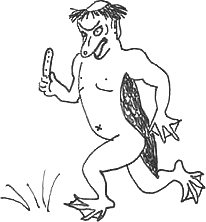 Below Text Courtesy of JAANUS
Below Text Courtesy of JAANUS
aisf.or.jp/~jaanus/deta/k/kappa.htm
Literally river child. A supernatural water-sprite believed to inhabit Japan's lakes and rivers. The name kappa varies from region to region, and includes kawatarou 河太郎, kawako 河伯, and kawaranbe 河ランベ. The appearance of a kappa also varies, but kappa are generally thought to be about the size of a young boy, and covered with green scales. They also have a snout, bobbed hair, and a saucer-like depression on the top of the head that holds water. When this water supply diminishes, the kappa's special powers diminish. Kappa swim well thanks to webbed feet and hands, but can also walk on land. Kappa also can rotate their arm and leg joints fully. Some kappa resemble otters, turtles with beaks, or have wings. Kappa are said to be fond of cucumbers and of sumo 相撲 wrestling. In some regions kappa are thought to be helpful, but generally their reputation is far more malicious. In particular, kappa delight in abducting humans and horses. Kappa are noted for their aversion to metal objects. Illustrations of kappa frequently are included in Edo period anthologies of supernatural tales. Kappa are often depicted in comical paintings (giga 戯画), in paintings accompanying verse (haiga 俳画), and occasionally in ukiyo-e 浮世絵 (woodblock prints; see above photo).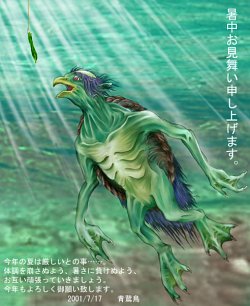
Modern Cartoon Drawing, found on web at:
www.tenchinohoukai.greatnow.com/backgroundinfo/weapons
Probably a Japanese drawing, but source not given at web site.
|
The defining characteristic of the Kappa is the hollow cavity atop its head. This saucer-like depression holds a strength-giving fluid. Should you chance upon the quarrelsome Kappa, please remember to bow deeply. If the courteous Kappa bows in return, it will spill its strength-giving water, making it feeble, and forcing it to return to its water kingdom.
About the size of a child aged 6 to 10, the Kappa is nonetheless incredibly strong. It attacks horses, cattle, and humans, usually dragging its prey into the water, where, according to various legends, it feeds on their blood, or drains their life force, or pulls out their livers through their anuses, or sucks out their entrails, leaving nothing behind except a hollow gourd. Stories tell of Kappa pulling little children into the water and drowning them. In many localities, drowning is still referred to as GAPPADOKO (ガーッパドコ). As drowning victims were sometimes found with a distended anus (swollen rectal), the Kappa is also sometimes called the shirokodama (anus) vampire. In some tales, the Kappa is associated with theft and raping women.
|
The Kappa's origin is difficult to verify precisely. But, by the Edo Period, illustrations of Kappa appear often in anthologies of supernatural tales, in comical paintings (giga), in ukiyo-e (woodblock prints), and in paintings accompanying verse (haiga). In 1910, Kappa lore gained nationwide popularity with the publication of Tono Monogatari (遠野物語; Legends of Tono) by Yanagida Kunio (1875-1962). In Tono Monogatari, Yanagida presented numerous tales of supernatural beings in the Tono area, including stories about the evil Kappa. Today the Kappa is typically depicted as a cute cartoon-like character (see photos below), and appears quite regularly in Japanese fiction, in cartoons for children (Urusei Yatsura, Tenchi Universe), as a cute mascot for commercial products, and in toys.
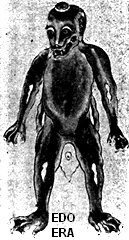 Theory One, Shinto Mythology.
Theory One, Shinto Mythology.
Some believe the Kappa is the "Kawa no Kami" (河伯; River Deity) mentioned in the Nihon Shoki (Chronicles of Japan, the Nihongi), one of Japan's earliest official records, compiled around 720 AD. During the Edo Era, we find mention of Kawatarou in a serial called Kasshiyawa (甲子夜話 | かっしやわ), first appearing in 1821 and running until the death of the author in 1841. We also find mention of the Kappa in the mid-Edo period document named 耳袋. For more historical notes and naming conventions, please click here (outside site, Japanese language).
- Theory Two, Leech Babies.
Some say the term "Kappa" was first applied to leech babies (stillborn infants pitched into the river). "In olden times, poor families often killed newborns because they could not afford to raise them," said an official from Tono City in a Yomiuri Shimbun article. "They generally threw their bodies into rivers. Perhaps adults made up Kappa stories so that children would be afraid to go near the rivers and see the dead babies." For details, please visit www.yomiuri.co.jp/nanjo/nanjo13.htm. In the 1910 classic book Tono Monogatari (Legends of Tono, 遠野物語), not all Kappa stories end happily. Many of the stories in the book deal with famines and the ill-treatment of stepchildren.
-
Theory Three,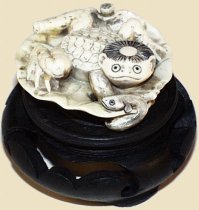
Ivory Kappa Netsuke
Early-Mid 20th Century
www.hanakagoantiques.com
Portuguese Monks.
Some say the term "Kappa" originated with the appearance of Portuguese monks in Japan in the 16th century. Clad in cloaks with hoods that hung down their backs like the kappa's tortoise shell, the monk's shaven pate surrounded by a crown of hair also resembled the kappa's hair-rimmed crater of water. Capa, the Portuguese word for the monk's habit, was applied to the sprite and remains in use today.Janet Leigh Foster, Big in Japan, #366, JapanToday.com >

- Theory Four, Chinese Monkeys.
Some say the Kappa descended from monkeys, most notably the writer Yanagida Kunio (1875-1962), the author of Tono Monogatari (遠野物語 | Legends of Tono). Yanagida is considered by most to be the father of Japanese folklore study, so his opinion carries weight. When comparing the different names used by different localities to describe the Kappa (e.g., Kawatarou, Gatarou, Kawako), Yanagida discovered that some areas in Japan refer to the Kappa as Enkou | 猿猴 | えんこう, the term for "monkey." Enkou appears in a famous Buddhist parable from China called Yuanhou Zhuyue (Japanese = Enkou Sokugetsu, 猿猴捉月). In this famous story, a group of monkeys attempt to catch the moon's reflection, but all are drowned in the effort.
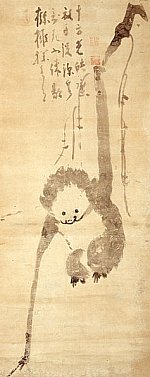
Enkouzu 猿猴図
Edo Period, 18th C.
Photo courtesy of
the Miho Museum
of Japan.
Click here for
another photo of Enkou from the Miho Museum
JAANUS>
One night a monkey chieftain saw the bright reflection of the moon in the water below his tree. Thinking that the moon had died and fallen into the water, and fearing that the world would thus slip into darkness, the monkey called together his underlings and commanded them to join tails and together pull the moon out of the water. However, when the monkeys attempted this task, their combined weight was too great, the branch broke, and they fell into the water and drowned. One simple moral of the story is not to recklessly attempt impossible tasks. On a more philosophical level, the image of the monkey attempting to grasp a reflection of the moon is a metaphor for the unenlightened mind deluded by mere appearances. The theme was often depicted in ink painting, usually featuring long-armed spider monkeys. The screen paintings by Shikibu 式部 (16c; Kyoto National Museum) and Hasegawa Touhaku 長谷川等伯 (1539-1610; screen painting at Konchiin 金地院, Kyoto), are representative.JAANUS quote>
There are many more indications of the monkey connection. In Tono Town itself, the Sarukaishi River (literally "Monkey Stone River") flows through the town's southern section (although I'm not sure when this name was given to the river). In Geishu City, Hiroshima Prefecture, the locals say a monster named Kawazaru (川猿 | かわざる | lit. River Monkey) lives in the waters there, attacking both men and animals. The monster is said to possess the power of 100 men, but its power evaporates if the water atop its saucer-like head is spilled. This Kawazaru story quoted from the Japanese-language site of the International Research Center for Japanese Studies. To learn much more about monkey lore in Japan, click here.
- Theory Five, Buddhist Monkey Mythology. Some say the Kappa originated from earlier Buddhist tales from mainland Asia, again tales concerning monkeys. This is actually a sub-theory supporting Theory Four above. Some examples include:

5A. The Monkey King and Water Demon
Among the many tales in the Jataka -- perhaps the oldest extant collection of Buddhist folklore, dating from around the 3rd century BC from India and Sri Lanka -- one story tells of a monkey kingdom confronted by a monkey-eating water demon, and how the wise monkey king outwitted the demon using bamboo. Please click here to read this story, courtesy of buddhanet.net. One site reader made the following comment: "It is possible that Kappa may be distorted form of Kapi which in sanskrit means monkey. There is a kapi-jataka, there is a mention of kapi jembawan (monkey sage)in Indonesian folklore based on kingdom of Dwarka where Lord Krishna ruled, there was also a place called Kapisthali in ancient India (now called Kaithal). Even Tulsidas, a famous Hindi poet who wrote Ramayana about 500 years ago, used the world kapi for Vanaras (monkey race) in South who helped Rama defeat Ravana."
5B. Journey to the West (西遊記, Japanese = Saiyuuki)
Journey to the West is a famous Chinese story (called Hsi-Yu Chi in Chinese). Although compiled by Wu Cheng'en in the 16th century, the legend existed long before that. It is based on a real person named Xuan Zang (602-664 AD), a Buddhist monk who journeyed to India in search of Buddhist sutras. Protecting him on his journey (in the book) are three companions -- the Monkey, the Pig, and a Water Demon called Sandy (Japanese = Sagojou サゴジョウ). To some, the Japanese Kappa is based on Sandy the water demon. According to Chinese mythology, Sagojou was originally the "Commander of the Heavenly Hosts," but he was banished to Earth for accidentally breaking the Jade Emperor's vase. On earth, he appeared as an ugly water spirit, devouring anyone who strayed near his abode. In Journey to the West, he is armed with a "water staff" with a metal blade on each end, and he wears a necklace of the skulls of his victims.
5C. More Supporting Theories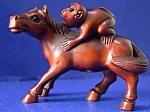
Monkey Riding Horse
Japanese Netsuke
Courtesy rubylane.com
Monkey "Protector of the Horse"
Another striking overlap between Monkey and Kappa lore is the horse. In Chinese tradition, the monkey is often shown riding the horse. This symbolism too stems from the classic Chinese story Journey to the West (see above), in which the Jade Emperor appoints the Monkey to the post of "Protector of Horses." See parts of this story here. The horse also appears quite regularly in Kappa mythology. Dozens of stories tell of the Kappa trying to drag a horse into the river, failing, then getting caught by the horse's owner, and forced to promise to never again harm the horses of the village. In this roundabout fashion, might we not call the Kappa a "guardian deity" of the horse? This topic is briefly explored at this site (J), which also discusses the serial stories called Kappa Heaven, which ran from Showa 28 to Showa 33 in the weekly Asahi Shukan. 実はそれ「清水崑 (シミズ コン)」って漫画家が書いた「かっぱ天国(昭和28年~33年まで『週刊朝日』にて連載)」の河童なんです。
- Theory Six, Ainu Origin. Some say the Kappa is of Ainu origin, but I cannot find any reference in Ainu folklore to support this theory -- although I admit my knowledge of Ainu mythology is woefully lacking. The Ainu, Japan's earliest inhabitants, live primarily in Hokkaido, the northernmost island, and their folklore is rich in imagery and monsters. Near Sapporo, the main city in Hokkaido, is an area called Jozankei, home to the "Great Kappa King" and the "Kappa Buchi Legend." However, the Jozankei legends are probably not of Ainu origin. Click here for details on Jozankei. According to the Angelfire web site: "The Ainu believe in a magical connection between trees and humans. For example, when a certain tree is cut down a girl will die. They feel that willows are like living humans and make miniature sacrificial willows from willow peelings (see also Willoughby-Meade, Chinese Ghouls and Goblins for more). The Ainu are also known for their Shamanistic beliefs and practices (perhaps of Siberian origin). To learn more about Ainu myths, please see Ainu Folk Tales by Basil Hall Chamberlain [1888; also the translator of the Kojiki]. The above link provides an online collection of Ainu tales from the book. One story in the collection is called The Old Man of the Sea (Atui Koro Ekashi). It describes an ocean monster able to swallow ships and whales.

Modern Kappa Paintings from Gabi Greve Collection
Yamashina-e & Otsu-e Photos of Kappa
Paintings by artist Yoshio Yamamoto
- Kappa Maki = Cucumber sushi rolls, a common Japanese food. The Kappa love cucumbers according to Japanese legend.
- Okappa = Bobbed hairstyles that look like the Kappa's hair.
- Kappa no Kawa Nagare = Even Kappa can drown. Even a Kappa can get carried away by the river. Kappa are excellent swimmers, so this is a proverb meaning "even an expert can make mistakes." There is a related proverb associated with the Monkey, which goes: Saru mo Ki Kara Ochiru. It means "Even monkies fall from trees."
- Kappa no He = Much ado about nothing (literally "water-imp fart")
- Kappa = Word for traditional straw raincoat worn by farmers
|
The chief delight of the quarrelsome Kappa is to challenge humans to single combat. Indeed, the Kappa delights in Japanese Sumo wrestling, and often challenges its victim to a sumo bout.
Kappa folk have a liking for cucumbers, a weakness that can be used to human advantage. According to one tale, an offering of cucumbers (on which are etched the name/age of family members) is enough to appease the Kappa, who thereafter will refrain from harming you and your family (need to find source for this). Even today, cucumber sushi in Japan is called "Kappa-maki".
KAWAKO KAPPA
The Kappa is sometimes called Kawako (literally "river child"). The name can be traced to Kawako-no-miya (Shrine of the Kawako), located on the bank of the Kawachi river near Matsue/Izumo. Legend relates that a nasty Kappa was captured near here and forced to sign a note swearing never again to harm any of the people or animals in the area. Unable to write, the Kappa dipped its hand in the ink and pressed it on the document. The document remained among the shrine's relics, and the Kappa never broke the promise (the Kappa is always portrayed as trustworthy and courteous despite its many evil ways).
KAPPA BRIDGE IN TOKYO
Tokyo's Kappabashi (Kappa bridge) was once farmland surrounded by canals prone to flooding. In the late Edo period a raincoat dealer Kappaya Kihachi devoted his entire personal fortune to building a drainage system. This difficult work took longer than expected and cost a fortune, and he was in despair until a kappa, whose life he had saved years before, suddenly appeared to help. With the kappa's assistance the project was completed in short order. In addition, those who had seen the Kappa were suddenly blessed with good fortune and soon the Kappa Temple was built, and the Kappa enshrined as a deity.
|
See below woodblock print.
The following myth has been passed down through the ages in Saga Prefecture. It was translated by Keiko Takada and Eriko Tsudo of Saga Women's Junior College, and appears on the Saga Pref. Government site at:
www.pref.saga.jp/soumu/kokusai/
sagasaga/archives/sagasaga9809.htm
Once upon a time in the village of Kawachino there lived a man named Genta. He was from a distinguished family in the village and was so wise and brave that he was greatly respected by the villagers. His house was large and stood near a river which flowed through the village. The river was at its deepest at the bend near his house, and the water looked dark and unfathomable, being over six meters deep.
One summer evening, Genta came back from his outing and told his servants as usual to hitch his horse to a shady tree near the river. After taking a short rest, Genta stepped out into the garden and looked at the tree. To his surprise, a kappa, the size of a 6-7 year old boy was dragging the horse by its hind legs into the river. The silent horse was resisting the pull with its forelegs while strangely enough, the servant as if in a trance, was helping the small kappa by pouring water into the cavity on the kappa's head. The more the servant poured, the more powerful the kappa became.
|
All of a sudden, the servant came out of his trance and followed his master's direction to hang the kappa upside down from the pine tree in the garden. Genta glared at the wicked water imp and reprimanded him. "What an insolent fellow you are! You take so much pride in your bit of supernatural powers and even try to steal horses from humans. You are very sinful indeed. I shall kill you as a warning to all of your fellow kappa."
With the precious water drained from his cavity, the kappa lost all his magic powers. The more he struggled, the tighter the rope cut into his flesh, making the pain even harder to bear. At last the kappa began to cry in a strange, harsh voice "please forgive me for mercy's sake my lord," he implored. "I'll not fail to make up for this crime, so please let me go." In tears, the the kappa begged Genta over and over again.
A kind hearted man by nature, Genta felt pity for the ugly creature who was crying. "If you swear with all your heart, I'll forgive you," he said to the kappa "but first, you must confess your sins and make restitution."
"I confess to you that I've done many wrongs," the kappa said. "I regret my past actions very much. Your authority is astonishing, so I promise you that even if the Kawachino River should flow upstream, I won't pull the people from this village into the water. Never will I do anything wrong again. Please spare my life today. I also promise to make all my fellow kappa keep this oath forever."


Kappa Statues at Gokoku Shrine, Gifu City
Photos by Reggie Thomson (http://www.reggie.net)
After the kappa swore his oath, Genta forgave him, took him down from the pine tree and untied the ropes. Placing both hands to the ground, the teary blue-eyed kappa bowed to him again and again. Then he asked Genta if he could go home to the bottom of the river.
"All right," Genta said, "but before you go, turn yourself around three times and recite your oath each time." The kappa obediently turned around 3 times, each time reciting his oath loudly. Kneeling down, he praised Genta, then went away.

After that incident, no more was to be heard of kappa in the village. Years later, Genta passed away, leaving behind the legend of subduing the kappa. The pine tree from which Genta hung the kappa, remained long after his death. Eventually however, the old pine tree too withered and died.
Whether the mystical kappa does in fact exist is still unknown. There is a sake manufacturing place in Imari called "Matsuura Ichishuzo" where, it is said that during restoration about 40 years ago, a small coffin was found between old boards containing a mummified kappa inside. The skeleton remains on display today for all who are interested in finding the truth.
"All right," Genta said, "but before you go, turn yourself around three times and recite your oath each time." The kappa obediently turned around 3 times, each time reciting his oath loudly. Kneeling down, he praised Genta, then went away.
After that incident, no more was to be heard of kappa in the village. Years later, Genta passed away, leaving behind the legend of subduing the kappa. The pine tree from which Genta hung the kappa, remained long after his death. Eventually however, the old pine tree too withered and died.
Whether the mystical kappa does in fact exist is still unknown. There is a sake manufacturing place in Imari called "Matsuura Ichishuzo" where, it is said that during restoration about 40 years ago, a small coffin was found between old boards containing a mummified kappa inside. The skeleton remains on display today for all who are interested in finding the truth.


LEFT: Giant Kappa statue near Tanukimachi Station
田主丸駅舎 Tanuki Machi Station, Fukuoka Prefecture
RIGHT: Stone statue near Tanukimachi Station
In modern times, the Kappa often appear as cartoon characters
 Below Text Courtesy of JAANUS
Below Text Courtesy of JAANUSaisf.or.jp/~jaanus/deta/k/kappa.htm
Literally river child. A supernatural water-sprite believed to inhabit Japan's lakes and rivers. The name kappa varies from region to region, and includes kawatarou 河太郎, kawako 河伯, and kawaranbe 河ランベ. The appearance of a kappa also varies, but kappa are generally thought to be about the size of a young boy, and covered with green scales. They also have a snout, bobbed hair, and a saucer-like depression on the top of the head that holds water. When this water supply diminishes, the kappa's special powers diminish. Kappa swim well thanks to webbed feet and hands, but can also walk on land. Kappa also can rotate their arm and leg joints fully. Some kappa resemble otters, turtles with beaks, or have wings. Kappa are said to be fond of cucumbers and of sumo 相撲 wrestling. In some regions kappa are thought to be helpful, but generally their reputation is far more malicious. In particular, kappa delight in abducting humans and horses. Kappa are noted for their aversion to metal objects. Illustrations of kappa frequently are included in Edo period anthologies of supernatural tales. Kappa are often depicted in comical paintings (giga 戯画), in paintings accompanying verse (haiga 俳画), and occasionally in ukiyo-e 浮世絵 (woodblock prints; see above photo).

Modern Cartoon Drawing, found on web at:
www.tenchinohoukai.greatnow.com/backgroundinfo/weapons
Probably a Japanese drawing, but source not given at web site.
LEARN MORE
- Suijin, Suiten, Mizu no Kamisama
The Kappa river imp is just one of Japan's many Suijin (literally "water kami"). But don't confuse the Kappa with the more powerful and more benevolent water deity of Shinto lore known as Mizu no Kamisama (also literally "water deity," also known as Suijin or Suiten).
- More Kappa Photos (this site, side page)
- Kappa Paintings from Gabi Greve Collection
Yamashina-e & Otsu-e Photos of Kappa
- Learn About Above Artist (Gabi Greve Site)
www.amie.or.jp/daruma/YAMASHINA-mini.html
Paintings by artist Yoshio Yamamoto, 63 years old (2004). What exactly are Yamashina-e and Otsu-e paintings? During the Edo Period, there were many travelers on the old Tokaido Road between Kyoto and Edo (Tokyo). Each of the 53 postal towns on the way had its own specialty -- mostly some local food. But Yamashina Town, and especially nearby Otsu Town, were famous for funny paintings with religious overtones. Yamashina is now a modern suburb of Kyoto.
- Other Names & Related Kappa Terms
http://toshigc.hp.infoseek.co.jp/genju/JAPAN/genju-jap-kapa.htm
www.ishinotent.co.jp/Kappa/kappa-2.html

GAPPADOKO
www.nichibun.ac.jp/YoukaiCard/1230651.shtml
In village after village, the Kappa is associated with drowning, and such incidents are referred to as "GappaDoko." また、馬とり淵という伝説があり、村々にはガーッパドコと言ってカッパがよく出没する魔所がある。
SAGOGAWA RIVER (さごがわ, Near Nagasaki
www1.odn.ne.jp/muraoka/kappa/tusima1.htm
This is one example where locals use the term Gappadoko, plus many other terms, like BUCHI, GAPPA, KIRIDOSHIBUCH, GAPPADOKO, GATSUPA. They say there is a deep deep water hole, nearly five fathoms deep, where some Kappa live.ブチには名があり、それぞれにガーッパがすんでいる。なかでも水死事故があったキリドーシブチを「ガーッパドコ」といい、佐護川のガーッパを統 制する「大将ガーツパ」のすむブチをゴージブチという。ゴージプチはプチの中でも最大、最深(約五尋)である。
- Yanagida Kunio (1875-1962)
www.pref.iwate.jp/english/folklore/folklore.html
www.ffortune.net/spirit/zinzya/kami/kappa.htm
Yanagida Kunio is the famous anthropologist who did the initial research on the Kappa and other supernatural beings in the Tono region (modern-day Iwate Prefecture). He is considered by some to be the father of Japanese folklore study, and the author of the classic Tono Monogatari (Legends of Tono), published 1910.
- TONO TOWN, TONO AREA, Iwate Prefecture
The Kappa and Kappa-buchi 河童淵 (river banks/spots where the Kappa hunt their prey) in northern Japan are especially famous. The area itself is surrounded by three mountains (Mt. Hayachine-san, Mt. Rokkoushi-yama, Mt. Ishigami-san), which are known collectively as the Three Mountains of Tono. Tono is well-known for its horse breeding, an activity pursued for centuries in the area. Tono is also a land of old folk tales, especially those about the Kappa that were recorded by Yanagida Kunio in his famous book "Tales of Tono." Visitors to Tono today can still taste old Japan, for the area still has many thatched farmhouses, fertility shrines, and images of the Kappa. The Sarukaishi River (literally Monkey's Stone River) gently flows through the southern part of Tono city. During its feudal days until the Edo Period, Tono flourished as a market place, lodging town and castle. On December 1, 1954, the eight villages of Aozasa, Ayaori, Kamigo, Matsuzaki, Otomo, Tono, Tsuchibuchi and Tsukimoushi merged to become the city of Tono. Today, the Tono area is home not only to the Kappa, but apparently home as well to the red-faced Tengu and a child-like spirit called the Zashiki Warashi. For more about Tono, please visit:
- www.asia-planet.net/japan/iwate.htm
- www.jandodd.com/japan/top10s_tohoku.htm
- www.anna.iwate-pu.ac.jp/~acro-ito/Japan_pics/
Japan_TON/imageidx.html (Photos of Tono Area) - www1.ourtokushima.net/kankyou/seikatsubunka/
awalife/march02/zashiki.htm
 KAPPA ORIGIN FROM CHINA.
KAPPA ORIGIN FROM CHINA.
Below site says Kappa originated from the
classic Chinese book "Journey to the West."
- www.brainyencyclopedia.com/
encyclopedia/k/ka/kappa__mythical_creature_.html
- www.brainyencyclopedia.com/
encyclopedia/s/sh/sha_wujing.html
- SAGOJOU, Sandy the Water Demon in Journey to the West
www2.plala.or.jp/kamkamkam/gimon3/no110/saiyuuki.htm
www.chinjuh.mydns.jp/sengai/mito/lg021028.htm
www.chinjuh.mydns.jp/sengai/mito/lg021028.htm
www.china-on-site.com/monkey.php
tenchinohoukai.greatnow.com/backgroundinfo/weapons
物語の中では「サゴジョウ」じゃなかったですっけということは、本場中国の「西遊記」に出てくる「沙悟浄」もやっぱり河童なんでしょうか。そもそも河童というのは、日本独特のものなのでしょうか。それとも中国あたりから伝わってきたものなんでしょうか。
- Kappa Myth by Janet Leigh Foster
metropolis.japantoday.com/BigInJapan/366/biginjapaninc.htm
- KAPPA FESTIVALS
- KAPPA ODORI DANCE, Hita City, Oita Prefecture
http://iris.hita.net/~city/eng/engmap.htm
A sacred Shinto dance to pray for abundant crops, in which young boys dressed as kappa (water imps) jump and cavort about in time to humorous music. Designated as a Prefectural Intangible Cultural Treasure.
- JOZANKEI HOT SPRINGS & KAPPA FESITVAL
www.asia-planet.net/japan/hokkaido.htm
The symbol of Jozankei Valley is the Kappa, the water sprite. Jozankei (valley) is a hot spring area and spa near Toyohiragawa River in southwest Sapporo (Hokkaido). Called "Sapporo's Back Parlor," the spa is surrounded by mountains, and was discovered by a monk called Jozan, and named after this monk for the efforts he made to develop it. The Kappa is the guardian spirit of the area. Local legend tells of a young boy who fell into a deep pool, where he was taken to the land of the Kappa, and lived happily thereafter (see below Kappa-Buchi Legend). Approximately 23 Kappa stand in various poses around the spa town, including the Great Kappa King. There is also a Kappa Pool, which becomes very lively during the Kappa Festival that takes place in early August.
Kappa-Buchi (Kappa Pool) Legend in Jozankei
According to local folklore, a young man was fishing in a deep pool in Jozankei, but fell in and never surfaced. Months later he appeared in his father's dreams to say he was living happily with the Kappa, and his Kappa wife and child. The pool is named "Kappa-buchi," or kappa pool, in light of this legend. <Courtesy Cathay Pacific>
- BOOKS
"The Kappa" & Other Works by Akutagawa Ryuunosuke
Japanese Author 芥川龍之介 (1892-1927).
Below text courtesy www.angelfire.com/sk3/asianhorror/a.html
Supernatural themes surface intermittently throughout his works. While his novella, The Kappa, is more satiric than supernatural, he discusses some of the contemporary psychic research in Japan. In Yabuno Naka, the dead speak through a type of Japanese medium. Other works have tangential references to magic such as Aguni no Kami and Christian mythology in Kirisutohoro Shoin Den, which strangely enough is about the former Saint Christopher. He dabbles in Chinese magic in Toshishun describing how to become a type of Asian magi or seinin. His mother died insane when he was young, and his father gave him up for adoption. Despite his inauspicious beginnings, he had a distinguished academic career at Tokyo University, married and fathered three children. Follower of Natsume Soseki, he produced a fine series of short novels and short stories during his brief lifetime. Cassell's Encyclopedia of World Literature describes his work as "weird and fantastic" and "often symbolical and impressionistic." He committed suicide during a stretch of severe depression. Akutagawa's The Hell Screen is the strongest tale of Japanese horror available in English, using a painter as the conveyor of horror. The Heresy, its sequel, is less successful as horror. Another of his tales, The Spider's Thread, shows the horrors of a Buddhist Hell and the chilling indifference of those in Paradise.
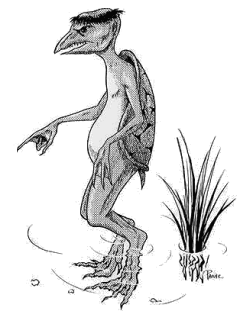
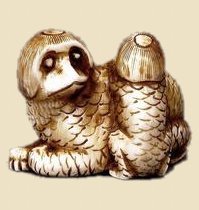
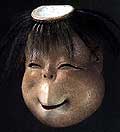
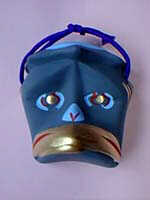
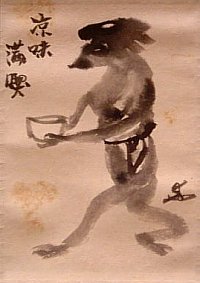
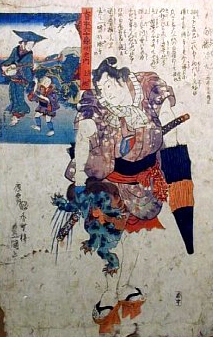
Comments